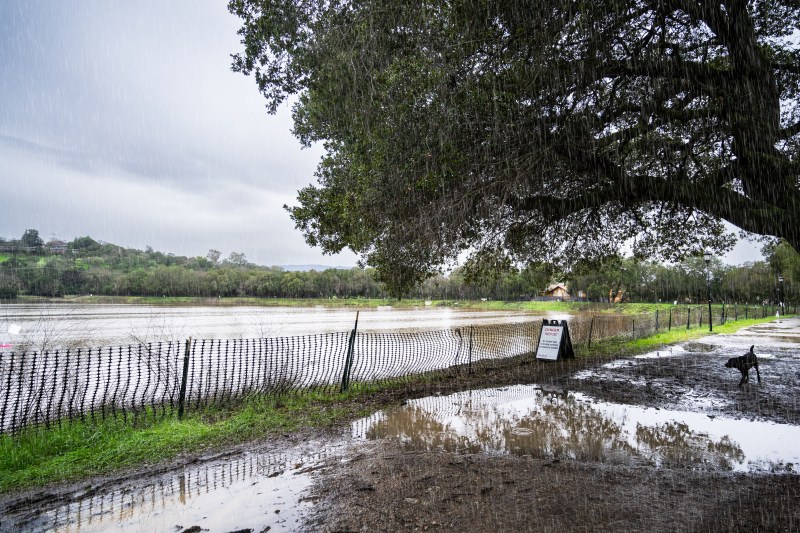Biking through the rain from EVGR to NVIDIA Auditorium, taking a stroll around a filled Lake Lagunita or forgetting an umbrella were a new normal for the start of winter quarter. Campus was cold, wet and inconvenient for many students, but outside the Stanford bubble, last week’s rain storms brought far more problems than getting rained on while heading to class.
For Isaiah Davies ’26, who grew up on Stanford Campus, this winter was clearly different from the past. “I don’t really remember a time where I’ve seen a full week of rain,” Davies said.
Davies was surprised to see the minimal damage on campus, despite flooding in Palo Alto. “The only real thing I’ve seen is the lake is back, which is something I haven’t seen in 15 years,” Davies said.
While students may enjoy seeing a full Lake Lagunita, the rainstorm wreaked havoc on California. The last few weeks of storms brought over 500 landslides, flooded rivers and roads, necessitated evacuations and caused at least 20 deaths. The near 32 trillion gallons of rainwater that fell across California over the last three weeks could reach damage costs as high as $1 billion.
With a history of droughts, this year’s flooding is an anomaly in recent memory. However, this rainfall is not as historic as it may seem, according to Sacramento County’s Public Information Manager Matthew Robinson. In a panel held by Stanford Woods Institute for the Environment last week, Robinson said floods are a recurring issue in California even amid a drought.
“Back in 2021, we had a storm system that dumped a historical amount of rain on our region,” Robinson said. “People think it’s safe because we’ve had years of drought. I just want to make sure that the public keeps in mind that they live in a flood plain.”
California is not unaccustomed to floods: every county in the state has experienced at least one significant flood event in the past 25 years. Still, the recent massive rainfall caused significant infrastructure damage, Robinson said.
Beyond immediate recovery from the rainstorm, Interdisciplinary Environmental Studies professor Chris Field told The Daily that more work has to be done to remedy the socioeconomic inequity highlighted by the natural disaster.
“It’s not that the impacts are only in communities with low resources that are otherwise marginalized,” Field said. “It’s that the ability to be resilient in the face of these impacts is just much greater in the wealthy communities.”
As climate change leads to more unpredictable and severe weather, inequities in flood resilience will become more pronounced, Field said. For people without medical, crop, home or car insurance, the damage from the flood may be more long-lasting.
“People with money tend to have many layers of protection. They have insurance policies. They have friends and relatives; they have a bank account with extra cash in it,” Field said. “If you don’t have any of those things, even a small disruption can be really catastrophic.”
Field explained that the flood was caused by atmospheric rivers. “We live in a region that has a history of cool wet winters characterized by having a number of substantial stormy periods that are connected with atmospheric rivers,” Field said.
“[These] are basically an organized feature of the atmosphere where flow from the ocean goes into what sort of looks like a narrow band.” These narrow bands can act as rivers and carry water vapor through the sky, Field said.
While atmospheric rivers usually occur weeks or even months apart, the past few weeks were an abnormal weather event.
“What’s really caused the excess water has been the rapid succession,” Earth Systems professor Noah Diffenbaugh said. “That New Year’s Eve storm we saw certainly flooded a lot of space for flood control. And then we’ve had additional storms coming on top of full reservoirs.”
According to Field and Diffenbaugh, the quick succession of this year’s storms, rather than the sheer amount of rain, made them so damaging.
“Certainly, having the same number of storms each delivering the same amount of precipitation but spread out over the course of several months rather than a few weeks would’ve been much less damaging,” Diffenbaugh said.
The unexpected sequence of atmospheric river events can be partially attributed to climate change, Field said. “One of the most consistent things we see in the climate models and in the observations is that at the global scale, warming is associated with more precipitation.”
The rain lifted California out of “exceptional” drought state for the first time since last May, according to data from the U.S. Drought Monitor. Despite the damage caused by the rainstorm, it provided a welcome respite from the drought for some.
The rainstorm “[brought] optimism during the ongoing drought crisis” to rice farmers in California, according to a statement from the California Rice Commission.
With all the rain from the atmospheric river, California may enter the next drought more prepared. However, without addressing the overuse of water that drives drought across California, it will continue to be an inevitable reality, Field said.
“We really have a long term problem with over allocation of water resources,” Field said.
Without additional rain later this year, California may still experience a dangerous wildfire season this summer, National Weather Service meteorologist David Sweet told the L.A. Times.
“If we don’t get our rainfall in January through March, we can be in for a busy fire season,” Sweet said.
Field echoed Sweet’s concerns and said wildfires will potentially be made worse with climate change. As average global temperatures increase, we can expect to see more weather variability, Field said. “We [will] have drier dry periods and wetter wet periods, and that’s a consequence of climate change.”
